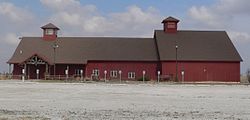Manley, Nebraska
Manley, Nebraska | |
|---|---|
 Lofte Community Theatre, on the eastern outskirts of Manley. | |
 Location of Manley, Nebraska | |
| Coordinates: 40°55′06″N 96°09′57″W / 40.91833°N 96.16583°W | |
| Country | United States |
| State | Nebraska |
| County | Cass |
| Area | |
| • Total | 0.11 sq mi (0.29 km2) |
| • Land | 0.11 sq mi (0.29 km2) |
| • Water | 0.00 sq mi (0.00 km2) |
| Elevation | 1,293 ft (394 m) |
| Population (2020) | |
| • Total | 167 |
| • Density | 1,477.88/sq mi (571.55/km2) |
| Time zone | UTC-6 (Central (CST)) |
| • Summer (DST) | UTC-5 (CDT) |
| ZIP code | 68403 |
| Area code | 402 |
| FIPS code | 31-30415[3] |
| GNIS feature ID | 2399242[2] |
| Website | https://ManleyNebraska.com |
Manley is a village in Cass County, Nebraska, United States. The population was 167 at the 2020 census.
History[edit]
Manley was established in 1883 when the Missouri Pacific Railroad was extended to that point.[4] An early variant name was "Summit".[5] The present name "Manley" likely was named after a local cattleman.[6][7] The village incorporated in 1954.[7]
Geography[edit]
According to the United States Census Bureau, the village has a total area of 0.09 square miles (0.23 km2), all land.[8]
Demographics[edit]
| Census | Pop. | Note | %± |
|---|---|---|---|
| 1960 | 113 | — | |
| 1970 | 150 | 32.7% | |
| 1980 | 124 | −17.3% | |
| 1990 | 170 | 37.1% | |
| 2000 | 191 | 12.4% | |
| 2010 | 178 | −6.8% | |
| 2020 | 167 | −6.2% | |
| U.S. Decennial Census[9] | |||
2010 census[edit]
As of the census[10] of 2010, there were 178 people, 66 households, and 48 families living in the village. The population density was 1,977.8 inhabitants per square mile (763.6/km2). There were 67 housing units at an average density of 744.4 per square mile (287.4/km2). The racial makeup of the village was 97.2% White, 0.6% from other races, and 2.2% from two or more races. Hispanic or Latino of any race were 0.6% of the population.
There were 66 households, of which 33.3% had children under the age of 18 living with them, 66.7% were married couples living together, 4.5% had a female householder with no husband present, 1.5% had a male householder with no wife present, and 27.3% were non-families. 21.2% of all households were made up of individuals, and 10.6% had someone living alone who was 65 years of age or older. The average household size was 2.70 and the average family size was 3.13.
The median age in the village was 43.5 years. 26.4% of residents were under the age of 18; 5.6% were between the ages of 18 and 24; 19.2% were from 25 to 44; 36% were from 45 to 64; and 12.9% were 65 years of age or older. The gender makeup of the village was 50.0% male and 50.0% female.
2000 census[edit]
As of the census[3] of 2000, there were 191 people, 69 households, and 52 families living in the village. The population density was 2,141.6 inhabitants per square mile (826.9/km2). There were 71 housing units at an average density of 796.1 per square mile (307.4/km2). The racial makeup of the village was 96.86% White, and 3.14% from two or more races. Hispanic or Latino of any race were 0.52% of the population.
There were 69 households, out of which 40.6% had children under the age of 18 living with them, 59.4% were married couples living together, 13.0% had a female householder with no husband present, and 24.6% were non-families. 18.8% of all households were made up of individuals, and 7.2% had someone living alone who was 65 years of age or older. The average household size was 2.77 and the average family size was 3.17.
In the village, the population was spread out, with 33.0% under the age of 18, 4.7% from 18 to 24, 34.6% from 25 to 44, 18.3% from 45 to 64, and 9.4% who were 65 years of age or older. The median age was 34 years. For every 100 females, there were 85.4 males. For every 100 females age 18 and over, there were 85.5 males.
As of 2000 the median income for a household in the village was $43,750, and the median income for a family was $52,500. Males had a median income of $33,750 versus $21,750 for females. The per capita income for the village was $16,398. About 6.3% of families and 5.9% of the population were below the poverty line, including 10.2% of those under the age of eighteen and none of those 65 or over.
References[edit]
- ^ "ArcGIS REST Services Directory". United States Census Bureau. Retrieved September 18, 2022.
- ^ a b U.S. Geological Survey Geographic Names Information System: Manley, Nebraska
- ^ a b "U.S. Census website". United States Census Bureau. Retrieved January 31, 2008.
- ^ "Manley, Cass County". Center for Advanced Land Management Information Technologies. University of Nebraska. Retrieved August 1, 2014.
- ^ "History". Cass County, Nebraska. Archived from the original on July 30, 2017. Retrieved March 24, 2018.
- ^ Fitzpatrick, Lillian L. (1960). Nebraska Place-Names. University of Nebraska Press. p. 32. ISBN 0803250606.
- ^ a b "Cass County History". Cass County. Archived from the original on April 2, 2016. Retrieved March 24, 2018.
- ^ "US Gazetteer files 2010". United States Census Bureau. Archived from the original on February 20, 2011. Retrieved June 24, 2012.
- ^ "Census of Population and Housing". Census.gov. Retrieved June 4, 2015.
- ^ "U.S. Census website". United States Census Bureau. Retrieved June 24, 2012.


